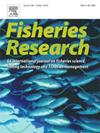在捕鱼器中,用什么鱼饵吸引黑鲷?
IF 2.3
2区 农林科学
Q2 FISHERIES
引用次数: 0
摘要
捕鱼对海洋生态系统造成的压力日益引起全世界的关注。如果按照适当的技术条例部署,使用诸如陷阱之类的被动饵具是一种选择性和低影响的捕鱼技术,可以促进海洋资源的可持续开发。在陷阱或鱼线的情况下,诱饵的选择可能会进一步增加渔具的选择性,特别是当决定是基于目标物种的进食偏好时。在本研究中,我们研究了不同类型的诱饵在吸引黑海鲷(Spondyliosoma cantharus)方面的效果,黑海鲷是一种在比斯开湾(法国)拥有健康种群的商业价值鱼类。具体来说,我们部署了一个没有陷阱装置的带饵水下摄像机,根据文献综述和对休闲渔民和专业渔民的采访,从10个选择中确定首选诱饵。由于诱饵的性能(吸引力)可能因评估方式而异,因此我们计算并比较了描述黑鲷与每种诱饵相关的行为的三个指标:每小时表现出兴趣或诱饵行为的鱼数,后者的特征是试图吃诱饵;这些鱼在诱饵附近停留的时间(称为停留时间);以及进入相机视野的鱼表现出诱饵行为的概率(称为诱饵概率)。鸟蛤与被饵鱼停留时间最长,被饵概率最高。蝇蛆对感兴趣的鱼停留时间最长,但诱饵概率最低。更一般地说,除人工诱饵外,所有诱饵都显示出吸引黑鲷的能力,但随着浸泡时间的延长,这种能力趋于下降。讨论了所使用指标的互补性,以及我们的结果在开发针对黑鲷的鱼网等被动诱饵装置中的应用。本文章由计算机程序翻译,如有差异,请以英文原文为准。
Which baits for attracting black seabream (Spondyliosoma cantharus) in fish traps?
The pressure that fishing exerts on marine ecosystems is of increasing concern worldwide. When deployed in compliance with appropriate technical regulations, the use of passive baited gear such as traps is a selective and low-impact fishing technique that can contribute to the sustainable exploitation of marine resources. In the case of traps or lines, the choice of bait might further increase the selectivity of the gear, particularly when the decision is based on the feeding preferences of the target species. In the present study, we investigate the effectiveness of different types of bait in attracting black seabream (Spondyliosoma cantharus), a commercially valuable fish with healthy populations in the Bay of Biscay (France). Specifically, we deployed a baited underwater video camera devoid of trap gear to identify the preferred bait among 10 options selected based on a review of the literature and interviews with recreational and professional fishermen. Because the performance (attractiveness) of a bait might vary depending on how it is assessed, we calculated and compared three indicators to describe the behavior of black seabream in relation to each bait: the number of fish per hour that exhibited Interest or Baited behaviors, with the latter being characterized by an attempt to eat the bait; the amount of time these fish spent in the vicinity of the bait (referred to as time of residence); and the probability that a fish that entered the view of the camera would exhibit Baited behavior (referred to as Baited probability). Cockles were associated with the longest time of residence of Baited fish and presented the highest Baited probability. Lugworm presented the highest time of residence for Interested fish, but the lowest Baited probability. More generally, all baits except an artificial lure demonstrated an ability to attract black seabream, but this tended to decrease with soaking time. The complementarity of the indicators used is discussed, as well as the application of our results to the development of passive baited gear such as fish traps targeting black seabream.
求助全文
通过发布文献求助,成功后即可免费获取论文全文。
去求助
来源期刊

Fisheries Research
农林科学-渔业
CiteScore
4.50
自引率
16.70%
发文量
294
审稿时长
15 weeks
期刊介绍:
This journal provides an international forum for the publication of papers in the areas of fisheries science, fishing technology, fisheries management and relevant socio-economics. The scope covers fisheries in salt, brackish and freshwater systems, and all aspects of associated ecology, environmental aspects of fisheries, and economics. Both theoretical and practical papers are acceptable, including laboratory and field experimental studies relevant to fisheries. Papers on the conservation of exploitable living resources are welcome. Review and Viewpoint articles are also published. As the specified areas inevitably impinge on and interrelate with each other, the approach of the journal is multidisciplinary, and authors are encouraged to emphasise the relevance of their own work to that of other disciplines. The journal is intended for fisheries scientists, biological oceanographers, gear technologists, economists, managers, administrators, policy makers and legislators.
 求助内容:
求助内容: 应助结果提醒方式:
应助结果提醒方式:


